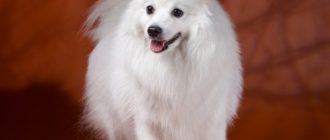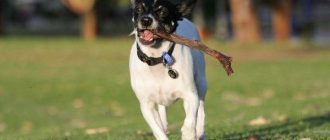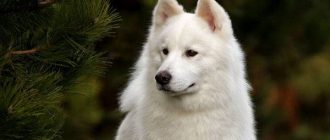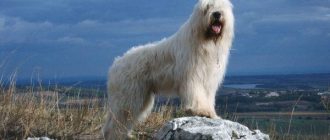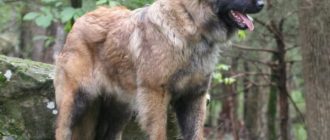Assessment of breed characteristics
Contents
| Adaptability Definition of how easy a dog is. can adapt to changes in life. |  |
| Shedding Level Level and frequency of hair loss in animal. |  |
| Level of tenderness Level and amount of tenderness and affection that the dog gives back in return for attention to itself. |  |
| Need for Exercise Daily Activity Level dogs. |  |
| Social need Required number of dog contacts with other animals as well as people. |  |
| Housing ratio Factor that determines the level of noise and other inconvenience that the dog can deliver to the owners in the ratio the size of the apartment to the size of the dog. |  |
| Grooming Number of bathing, combing, as well as necessary number of professional grooming sessions required the dog. |  |
| Friendliness in an unfamiliar environment society with strangers or in an unfamiliar environment. |  |
| The tendency to bark The tendency to bark and its frequency and volume. |  |
| Health Issues Potential Health Status dogs. |  |
| Territorial tendency of the dog to protect his house, yard or even a car owner. |  |
| Cat friendliness A trend towards cat tolerance and reduced manifestation of hunting instincts. |  |
| Intelligence Dog’s ability to think and solve emerging difficulties (not to be confused with learning!). |  |
| Education and training Level of difficulty in training a dog perform certain actions. |  |
| Friendliness for children Factor determining how much the dog friendly to children, whether she likes to play with them and endure some children’s pranks. |  |
| Game activity The concept is determined by its very name, and, usually found in almost all dogs. |  |
| Observability Dog’s ability to detect presence a stranger in his territory. |  |
| Friendliness for other dogs Dog’s tendency to find common language with other relatives. |  |
Brief description of the breed
Siberian Husky is a beautiful breed of dogs with a thick coat various coloring. The blue, sometimes multi-colored, eyes of this dog fascinate with its beauty and penetration. Breed removed was in Siberia. The dog is very similar to a wolf. The animal is very active and extremely smart, sports breeds. Husky pluses:
- Good friend for kids;
- Ideal sled dog;
- Very temperamental;
- Smart;
- Friendly towards people;
- Does not bark;
- Easily tolerates a change of residence with by the owner;
- It does not have an unpleasant odor.
Husky Cons:
- Not suitable as a watchman;
- It does not have the instinct of a protector;
- Prefers to live in a company of dogs;
- It has a tendency to destruction;
- Can run away;
- Spoils the garden, digs holes;
- It does not tolerate heat;
- Poorly tolerates loneliness;
- Left alone, begins to howl;
- Very shedding;
Siberian Husky conquered thousands of ordinary people around the world. IN artists, writers, musicians, directors, who often sing this breed in their works. This is not amazing It’s impossible not to fall in love with the bottomless eyes of this a cute and affectionate dog. The dog is medium in size, refers to working breeds. Bred as a ride dogs. The stunning ability of these amazing animals to learning. Moreover, the animal is stubborn enough, which is the main reason for the difficulties of training, for the success of which it is necessary to achieve the location and trust of the animal. The breed is not Designed for any dog breeder. Often the beauty of an animal becomes the reason why it is acquired by the unprepared amateur dog breeders. However, many do not know about the features the complex nature of the animal. All this caused an increase. the number of representatives of this breed in various shelters. Unprofessional education and ignorance of the basics of Siberian content husky leads to the fact that the animal shows the worst features of its character. Having carefully considered all the positive aspects, you You can see the true uniqueness of this breed. Siberian Husky is smart and independent. They show tenderness and real warmth to relatives. With great desire, the pet will hold time with the child, showing attention and care to him. Despite sharp mind, Siberian husky is not easy to train. therefore the dog is suitable for experienced, confident dog breeders who possess professionalism and unlimited perseverance and patience. A feature of Siberian husky is a tendency to shoots from home. The pet, if possible, can run away from home, to wander “free”. This often causes death. or injuring an animal. Prerequisite for the owner Husky – constant monitoring of the dog, fencing the yard with a reliable fence. Despite the presence of certain factors complicating keeping and raising a husky, this breed remains popular, and by truly amazing. If you are willing to make maximum effort, show persistence and patience in education, then you can decide to buy this dog, which will become a true friend.
Appearance
Husky is a medium-sized dog with a strong, but not dense body structure. Torso slightly elongated, chest cage deep set, not too wide, back straight and even, the back is slightly down. Croup the dogs are lean, narrower than the ribcage. The tail is covered with a lot of wool, set below the line spine, resting and lowered and hanging, and only when the dog is agitated, raised above the spine, like a saber. Forelegs moderately spaced, parallel to each other friend and direct. The shoulder blades are at an angle, the elbows widely set. The hind limbs are parallel, noticeably bent. Paws are oval, dense, covered hair. Neck proudly worn, arched, densely covered with hair, when running, the head is extended forward, it seems that she’s a little ahead. The head is proportional to the body. The skull is markedly marked, the muzzle narrows to the nose. The nose is straight from the skull to the tip of the nose. Lips fit tightly, scissor bite. Eyes almond-shaped, located slightly obliquely, dark brown or blue. Allowed, although not is desirable, eye color of different colors. Ears set high triangular in shape, slightly rounded on the tassels. Thickly covered wool inside and out. Proportionality and appearance the body is reflected in the motility of movements, speed and endurance. Huxi have a characteristic walk, so smooth and harmonious, that it seems that they are not attaching to it no effort. It is because of this that they cope perfectly with task of a sled dog that is able to drag with an average speed light loads over long distances. Male breeds Siberian Husky are never dense, but bitches are a little drier their physique, although by no means physically weaker. At proper care of the dog, strong are clearly visible on the body and well-defined muscles without traces of excess weight.
Wool
Siberian Husky wool is two-layer, medium length, coat very lush and thick. The undercoat is lush, soft and thick, wool the upper layer is straight, rather rigid and, rather, adjacent.
Color Siberian Husky
There is a completely different color of Siberian husky in the standard All colors from black or pure white to dark chocolate with shades of red to gold. However, to colors that can be found most often include: black, gray, wolf, silver, red, chocolate or golden with white dots as well as spotted. Arbitrary is also allowed drawing on the head, although most often the face is painted white along with the front of the skull, and the rest may be painted in any of the above shades.
Photo of Siberian Husky:
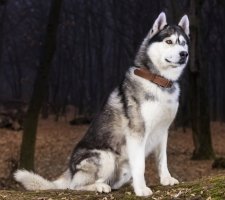
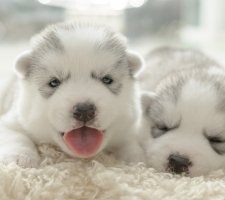
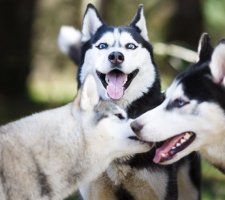



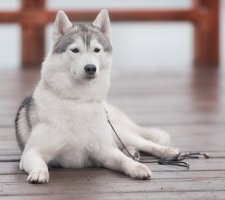
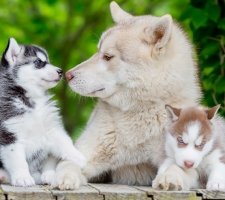
 Photo of Siberian Husky dogs |
Photo of Siberian Husky dogs |
Origin history
It is believed that Siberian husky was bred in nomadic tribes. Chukchi. The history of the breed is genuinely unknown, but DNA tests speak of that the breed is one of the oldest on the planet. Exactly it is known that the Chukchi successfully used these dogs for sleigh ride. Dogs for this people have become full family members. Often they slept with children, warming them with their warmth. In 1908, Siberian Husky was brought to Alaska. There animals were used as sled dogs. They are especially popular. were at the time of the so-called the gold rush. Husky quite often become participants in various competitions. It is established that Siberian Husky was last taken from Siberia in 1930. When the Soviet government closed the borders, the export of the breed became impossible. At the same time, the pet continues to thrive in different parts of the world. of our planet. Despite the appearance of modern husky slightly different from those that were the companions of the Chukchi, the nature of the dogs has not changed much. The Siberian Husky was recognized The American Kennel Club as a separate breed in 1930. Eight years later, the first club of fans of this breed. It should be mentioned that already in 1939, after USA, Siberian Husky was recognized by the Canadian Kennel Club.
Siberian Husky Character
Siberian Husky is by nature very attentive, not aggressive dog, so it is not suitable for execution duties of a guard or watchman. Its attention among millions they deserve people thanks to their exotic appearance, because these dogs are very similar to a wolf. Husky adore his master, with love other animals, they are friendly to strangers to people. All these qualities make the Siberian Husky a great dog – companion. Dogs of this breed are very cheerful, each exit to street for them as if for the first time. Despite this, husky distinguished by great curiosity and energy. Such a dog is unlikely suitable for beginners who previously did not contain dogs. For so that the pet meets all the expectations of its owner it is necessary to spend a lot of strength and energy. In details You can familiarize yourself with the nature of Siberian huskies here.
Maintenance and care
Siberian Husky – easy to care and maintain, they do not have unpleasant odor, and indeed, these animals are very clean. IN In this regard, they can be compared with cats. That is why bathing a husky necessary only when such a need arises. Husky shed on throughout the year. The most active molting period occurs twice in year. It is noteworthy that dogs that live in colder climate shed less than their counterparts from warmer regions. To prevent the spread of wool around the house comb out your pet at least once a week. During active molting requires daily combing. Inspect weekly the ears of your pet. Make sure that there are no irritations and signs of an inflammatory process. Handle the auricles better solution prescribed by the veterinarian. No need for this use cotton, it is better to take a special swab from a soft cloth. For the prevention of tartar and gum disease every week you need to brush your dog’s teeth. Monthly clipping a claw will also be sufficient, however, if claws grow fast, it may be necessary to trim them more often.
Training and training
As for all other breeds, for Siberian husky is necessary compulsory training and socialization. Help will be useful professional and training a dog in a special training class.Many husky owners claim that their pets perform all the teams that the trainer gives in the classroom, but upon arrival home, the dog refuses to execute any of the commands. It’s connected with by the fact that husky are stubborn and difficult enough to train, and this is another good reason saying that newcomers do not cope with husky dogs. Dogs of this breed require assertive, self-confident master. Often animals are manipulated by uncertain the master in himself, resorting to the help of his charming look. Therefore, all family members should be aware of what the dog needs. be stricter (without aggression, of course), especially during training and training.
Health and Disease
Siberian Husky tolerates bad climatic conditions very well. conditions, but it is worth considering that in a well-heated environment apartments, the dog may become pampered and lose its innate endurance. Husky comes from the North, so they can perfectly themselves feel in the garden, while curled up in the snow and fall asleep for a long time, to the great horror of their owners. Of course, husky not made of steel, but remember that they are very resistant to conditions frost, but on one condition: if we do not spoil the natural the structure of their coat. Never shorten the coat of your pet, otherwise the coat will lose its insulating properties. After bathing, the dog should dry completely before than you let her out, otherwise she may catch a cold. Unfortunately, drying after bathing takes enough a lot of time. Dogs of this breed have absolutely no tendency to hip dysplasia, cases of this diseases concern mainly dogs raised pseudo-breeders who don’t care if their parents are sick puppy any disease. Real breeders are usually preliminarily conduct a lot of research to exclude the possibility of hereditary diseases such as dysplasia hip joint or progressive retinal atrophy. Exactly in such people it’s worth acquiring puppies. Remember not to strongly boost the active growth of the dog, it needs to be fully feed, but at the same time, you should not overfeed and allow it weight gain. Recall that Husky is very sensitive to zinc deficiency, which can cause skin problems, which pass quickly if you revise the diet, replacing it nutritious nutrition rich in essential nutrients.

